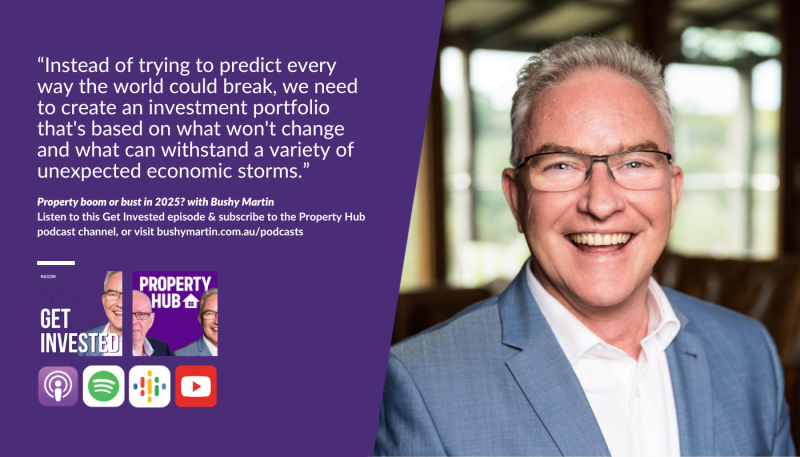A return to normalcy within the property market, a slower rate of growth, and interest rate reductions can be expected in 2025.
With commentary on the property market saturated with inflammatory language designed to tap into investors’ fear and greed responses, KnowHow’s Bushy Martin instead provides the facts on what to expect in 2025.
Using data and forecasts provided by a range of credited courses, including SQM Research, CoreLogic, Domain, and the four major banks, Bushy provides insights on the Get Invested podcast which will allow listeners to better read property conditions and make better decisions to suit your strategy.
2025 Property Predictions: Slower rate of growth
Bushy discussed the data which indicates a return to normalcy within the property market, with significant location variation and divergence, and growth slightly softer and a paler carbon copy and repeat of 2024.
“The SQM base case forecast is for average national dwelling prices to rise between +1% to +4%, amongst continued divergent locational variation. Perth, Brisbane, Adelaide and Darwin are expected to outperform again, with Perth growth 14 – 19%, Brisbane growth 9 – 14%, and Adelaide growth 8 – 13%. Meanwhile, it’s predicted that Canberra will experience a price drop of 2 – 6%, as well as Sydney and Melbourne by 1 – 5%. Finally, Hobart is more neutral on -3% to +2%. So it’s similar geographic variations as this year but toned down, and still good above average growth generally,” Bushy said.
“Domain’s End of Year Wrap Report indicates a slow down in growth this year, and while they see much weaker housing conditions, they’re still predicting house values in every capital to increase, especially when interest rates start cutting, which they predict will be in the second half of the year. So they’re forecasting a property year in two halves. Domain are also expecting combined capital city median values to rise by 5 – 7%, with Perth continuing to lead the charge with 8 – 10% growth, bringing the median price to $984k. For the first time in 20 years, they suggest Sydney and Melbourne will have a gap of 60% in their median prices, with Sydney at $1.75M and Melbourne at just over $1M. In fact, they predict five out of eight capitals – Sydney, Melbourne, Canberra, Brisbane and Adelaide – will have a median house price over $1M, with Perth not far behind. So overall, the data shows weaker level of growth due to affordability constraints.
“However, there is a danger of relying on area aggregated median property prices, as they only give an overall indication of direction and sentiment, but the devil is in the detail and a world of property opportunity sits below the numbers. So treat them with a grain of salt.”
2025 Property Predictions: Interest rates cuts
Bushy revealed that interest rate cuts are to be expected in 2025, however the timing and size of these cuts will continue to be dependent on inflation, global economic conditions, and Australia’s economic performance.
“The SQM forecast is that we’ll have an interest rate cut of 0.25% to 0.5% by mid next year, assuming inflation continues to fall and the economy softens. If interest rate cuts do occur, SQM believes this will stimulate buyer demand across the country and will limit dwelling price falls for Sydney and Melbourne. Domain predict three rate cuts, with the RBA cash rate dropping from 4.35% to 3.6%. This means home loan rates will drop down into the 5 – 5.5% range, which will reduce your repayments but also increase your borrowing capacity. Finally, the big four banks all differ on when and how much they predict rates to drop, with CBA and ANZ forecasting the first rate drop in February 2025, while NAB and Westpac tip rate cutting delayed till May 2025,” he revealed.
“Now the wild card impact on interest rates and the timing of cuts is likely to be influenced form the lagged flow on effects of what actually happens with the US economy and US rates once Trumps new show ‘The Apprentice White House Series 2’ kicks off in January.”
2025 Property Predictions: Population growth and immigration to remain consistent
Migration numbers in Australia will continue to put pressure on housing demand.
“Before covid, net migration was projected to hit about 300k by 2025. But unsurprisingly, 168k fewer people were added to the population from 2019 to 2024, relative to the long-term trend caused by 508k fewer people arriving during the pandemic lockdowns, as well as a post-lockdown rebound of 340k extra people to March 2024. But Australia’s net migration is still 82k short of pre-pandemic levels according to a recent ANU report, so this will continue to put pressure on housing demand, with 240k migrants per year ongoing,” Bushy said.
2025 Property Predictions: Scarcity and supply shortages to continue
Bushy said investors can expect the growing demand and reduced supply to continue into 2025, with the increasing gap creating great opportunities for investors in high-demand scarce-supply locations.
“According to the National Housing Supply and Affordability Council, 169k households are on public housing waiting lists. Nationally we’re somewhere between 250k – 400k houses short right now, so this is likely to get worse not better. This scarcity is good for investors as it creates upwards price pressures in low-supply high-demand areas, but not so good for home buyers,” he said.
“There will still be an undersupply. We need a minimum of 240k new dwellings per year, but only 172k were completed in 2023 and we’re currently at 180k this year. Therefore, we’re getting worse by 60k a year and the Government’s housing fund will be too little too late to make a meaningful dent in this because we won’t be able to build enough of the right types of homes in the right locations.
“There’s also the construction challenge of builders still going bust. A lack of labour leading to an 89k shortfall, prices going up 40%, and properties taking 40% longer to build results in building not being profitable. So again, this growing shortage, particularly for houses, is great for investors.”
How should property investors respond?
Bushy recommended that property investors plan for the worse and expect the best, and rely on TLC – Time, Leverage and Compounding.
“Instead of trying to predict every way the world could break, we need to create an investment portfolio that’s based on what won’t change and what can withstand a variety of unexpected economic storms. You need to give yourself and rely on TLC – time, leverage and compounding,” he said.
“If you were patient and persistent enough to slowly grow your wealth in property over any 20-year period in the last 70 years, you would’ve been rewarded with a 700% return on average and had a 0% chance of losing your money. But sadly, most investors are too impatient to follow this massive-upside, minimal-downside strategy because they try to compress that natural 20-year+ investment window. So the question you need to ask yourself when investing isn’t, ‘what’s the best return I can get this year?’, but rather, ‘what’s the best return I can sustain for the longest period of time?’. Then, you structure your properties so you can afford to hold then through thick and thin over the long term.”
Listen to the interview here.
Want to Know How you can build wealth and optimise your property finance with the help of leading, qualified experts? Check us out and talk to the team, now.




